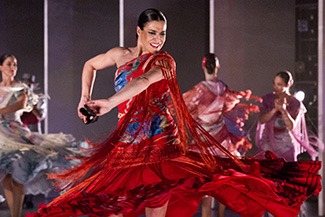
Photographer: Stanislav Belyaevsky PHOTOGRAPHY
Sorolla, the Ballet Nacional de España’s exuberant paean to the work of impressionist painter Joaquín Sorolla y Bastida, was a masterpiece of style, color and substance on stage at the Arsht Center in its performance run Nov. 6 through 9. From the gorgeous costuming of Nicolas Vaudelet to the vivid and evocative projections by scenic director and Cirque du Soleil veteran Franco Dragone, every element worked together to envelop dancers and audience in a stirring journey to a more innocent time in a bygone Spain.
The projection of an antique picture frame around the stage’s proscenium was the cue that Sorolla’s paintings would be inhabited before us. The sea, a favorite subject of the Valencian artist, was suggested by the huge silk cloth that poured out of another, smaller frame in the center of the back scrim. White silk morphed into a tunnel of waves from which, Venus-like, emerged a solitary female dancer. With beautiful extensions and guileless charm, she seemed at once the painter’s muse and the audience’s guide into his artistic world.
From this lyrical beginning, artistic director Antonio Najarro catapulted us into the exuberant energy of the light-hearted Galician muñeira. Nine couples snapped their fingers and swung their arms windmill-like, skipping in and out of formations with abandon, as if dancing a wild Irish jig.
The Aragonese jota was another megawatt folkloric dance that could only be performed with this level of athleticism and artistry by a troupe like the Ballet Nacional. In espadrilles and heavy woolen socks, the couples faced off in a wide stance, arms U-shaped above their shoulders and castanets flapping. The men formed a circle, grasping each other’s shoulders, legs flying out behind them as they spun around in a vortex.
Finally, the corps rushed headlong toward the audience, the men jumping high, knees bent, toes clicking together in the air. The full house on Saturday evening applauded wildly.
Even with the widely divergent styles that Sorolla explores, the program succeeded as a seamless, unified whole because Dragone, along with Najarro and fellow choreographers Arantxa Carmona, Miguel Fuente and Manuel Liñán, wove visual metaphors throughout to tie disparate elements together. Thus the billowing cloth from the first scene was echoed later in the projection of a brilliant crimson curtain blowing across the stage. Similarly, a long red net was dragged in a diagonal in “El Pescado,” catching not a fish, but a beautiful woman. In the final number, the women’s large white shawls moved sinuously, echoing the white silk cloth that opened the evening.
With the backdrop of Sorolla’s gorgeous “El Baile” behind them, the stirring bulerías finale took place at a sun-drenched celebration in a Sevillian courtyard. Looking like a goddess in a cardinal-red dress fashioned from a mantón de Manila, soloist Esther Jurado seemed to have stepped out of Sorolla’s painting, and her powerful stage presence filled the space like a lightning bolt of pure, unadulterated joy. When the full company joined her onstage, six brilliant flamenco musicians playing behind them, the electricity was palpable. A breathtaking denouement to a thrilling evening of dance.
Helena Alonso Paisley is a dance critic for www.artburstmiami.com.
 MAIN MENU
MAIN MENU

